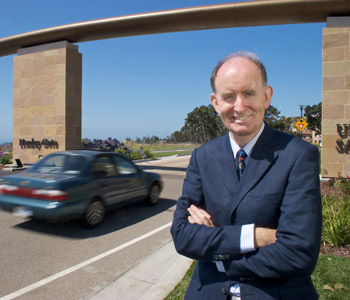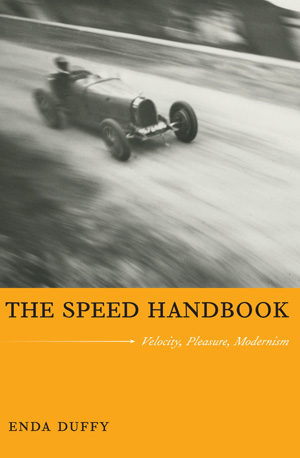
The Speed Handbook is first and foremost devoted to exploring the thrill you feel when you experience intense new speeds.
Of what, exactly does the thrill of speed consist? Can speed’s excitement be harnessed and redeployed to energize the ways we live?
I suggest that this is exactly what happened for the first time in the modernist era, when the speed of the newly invented automobile allowed people at last to feel modernity in their very bones.
The Speed Handbook argues that access to intense new speeds for masses of people, with the arrival of the automobile and its instant acceptance, is a crucial sign of a new level if intensity that was offered to people in modernity.
Speed revolutionized people’s sense of space and territory. It gave drivers a sense of how, through this new technology, they might live their lives more intensely. It introduced them to new levels of physical risk and the powers of technologized violence: the crash. It placed them, even in their leisure moments, ever more fully under the surveillance of the law.
The modernist era, which followed the invention of the mass-producible motor car after 1896, marked a new regime of personal thrill-reward, personal risk and personal responsibility, all centered on offering masses of people access to hitherto-incredible speeds.
“We have become blase to speed: we would now need to drive very fast indeed to experience what those earliest drivers felt at, say, 45 mph.”
In a 1931 essay, Aldous Huxley asked a brilliant question: “Has modernity, with all its stress on progress, on inventiveness and on the new, actually give humankind any truly new experience, any new pleasure?” His answer was that he could only, finally, think of one: the experience of speed.
The Speed Handbook takes up the challenge of Huxley’s claim: if speed is modernity’s single new pleasure, the one experience invented in the modern era that has not been experienced with such intensity ever before, then speed needs to be understood in order to understand modernity itself.
The Speed Handbook ranges through the fascination with speed in the years 1900-1930 in particular, in both high art and the new popular culture genres. This is seen above all in the newest medium, the movies, but also in novels, in photography, advertising, theme parks, speedways, and car design. These were the arenas in which speed’s impact could be celebrated, interpreted, critiqued.
I suggest that many of the radical new forms of modernist high culture, and even more the original formats being pioneered by the new mass media, were developed to represent speed’s thrills.
From the very beginning, to take an obvious example, movies were obsessed with the car chase. Every genre of modernist culture was fascinated by speed: think of the auto-race snapshot-photographs of J. H. Lartigue, novels form The Wind in the Willows to The Great Gatsby to Virginia Woolf’s Orlando, the rants and metal-fluid sculptures of the Futurists, the modern portraits of Tamara de Lempicka and the posters of A.M. Cassandre. Even Matisse painted French landscapes framed by a car windscreen.
The mass car culture of the post-war era and the sixties reaction generated a new wave of car-obsessed texts: J. G. Ballard’s Crash, Godard’s film Weekend, Ralph Nader’s Unsafe at any Speed. These varied documents of car-culture, horrified and transfixed by speed’s thrills, educated people in how to handle speed even as they improvised new ways to represent its excitements and its protocols of controlled fear.
The automobile, site of all this attention, is the most characteristic artifact of modernism. The automobile has wrought such havoc on the planet that we forget its originality—and the nature of the pleasure of the speed it provides. Its mass adoption allowed people to experience speed as a sensation. The sensation of speed made possible by the automobile meant that modernity could now be experienced as a physical effect on modern bodies. (Since those early years, we have become blasé to speed: we would now need to drive very fast indeed to experience what those earliest drivers felt at, say, 45 mph).
This new technology, for those first drivers, stretched people’s senses of perception to new limits. It demanded a new alertness, faster reaction times and coordination of body to the machine.
Thus car culture, both in its high and popular forms, is one site where the usual narrative of modernist alienation turns out to no longer be credible. The Speed Handbook looks at representations of speed in the inter-war years to challenge the story usually told about the function of modernist art as a latter-day metaphysics of alienation.
The revolutionary strangeness of the high modernist art of Joyce, Picasso, Woolf and the rest is often accounted for as these artists’ response to a modern sense of alienation—that is, the awareness that modern subjects were losing touch with sensuous reality, and therefore feeling a low hum of discontent, a middle-class anomie.
Picasso’s distorted faces, for example, or the boredom-laden cadences of T.S. Eliot’s dawdling lines, are taken to be indices of this modern alienation from a vibrant real. Car culture, which might at first appear banal and “low,” presents in the same years an antidote to this aesthetics of ennui. It is all about dynamism, about excitement, about the frisson of pleasure, along with the terror, of the speed thrill.
How then can we read it? The Speed Handbook suggests that it is the arena in which there developed a nascent “adrenaline aesthetics,” whose cultural forms were much more in your face and immediate, and which was geared to annotating the somatic experience of the thrill of speed which might be experienced by the modern individual as a counterpoint to the unbearable heaviness of anomie.
The book describes how, with new speeds, there also developed a new awareness of slowness. By attending in their texts to the slow, by making us party to the dreariness of waiting in line, high modernist texts were both evidencing their fear of the new technology-driven modernity, and, despite themselves, inciting their readers to move instead to the rhythms of increased speeds.
There is a history of slowness that runs in tandem with the history of speed. In the book, the crowning example of this is Joseph Conrad’s Heart of Darkness, a great hymn to slowness, imperialism and how both relate to what we like to call progress.
“Adrenaline aesthetics,” I posit, insinuates its frissons into every cultural production, so that modernist artworks in fact work to shed the old perspective-based aesthetics of critical distance and the static, still, position it requires, in favor of a multiple-perspectival, unfixed, always moving viewpoint—whose movement has a rate, a rate of speed.
The new speed culture came with a politics. First, it was a politics of access: the rich were granted greater speeds earlier. As the masses, too, at least in the West, gained access to technologized speed, new political implications became evident.
At one level, enjoying the automobile’s speed, which the vast car advertising sold as a leisure activity, might be seen as a compensation for the alienation of work. The Ford assembly-line worker, doing repetitive work with machines each day, could experience the machine as thrill on the weekend drive.
Yet speed’s thrill, apparently so mundane and personal, achieved much farther-reaching political effects. Speed, experienced somatically with the help of technology, altered people’s relation to space. Before, the home had been cast as the—static—place of pleasure: the unknown world beyond, as the place of threat and possible adventure. With the automobile and its thrills, the home ceased to be the place in which to experience the best of modernity. And the far-away world was no longer the place of fantasy, as it had been, for example, in imperial adventure tales. Now the space of movement thrilled more than any place. I suggest that this coincided with the moment when the whole known world was mapped, and the last age of European imperialism was about to end.
Car culture, in other words, accustomed us to a world in which movement, rather than territoriality, would be demanded of us and made pleasurable.
Adrenaline was isolated by Jokicki Takamine in 1901. And it was at once described in terms of human energy, of movement, as “fight or flight,” as the source of increased alertness. The automobile, at almost the same moment, become the technology with which one’s alert reflexes, powered by adrenaline, could be tested and exercised.
Both the new technology and the new drug (for adrenaline was synthesized and marketed soon after) were part of a new cultural interest at this moment in human energy. In the case of the car, it was as if the new technology as prosthesis involved such a display of mechanic energy and speed that the human organism felt the need to measure up.
Both adrenaline and automobile speed thrills are symptoms of the new role of energy at this moment in the very definition of human life itself. Just as there is a history of slowness as well as a history of speed, a history of human energy too remains to be written. The turn of the century moment that saw the isolation and description of the role of adrenaline is a key transformative moment in that history.
“Before, the home had been cast as the—static—place of pleasure: the unknown world beyond, as the place of threat and possible adventure. With the automobile and its thrills, the home ceased to be the place in which to experience the best of modernity. Now the space of movement thrilled more than any.”
Though I barely use the word in the book, I hope The Speed Handbook contributes to the growing field of biopolitics.
By “biopolitics” I mean the ways in which, in modernity, various powers, such as—but not only—the state, have progressively made the human body, its well-being, and its very life, the subject of their attention. Clearly, technology and science, as well as culture, have played a huge role in the advance of a politics of “bios.”
In other words, it is not enough that those in power influence what we think; there is even more at stake in controlling our bodies, and in controlling life itself. Our sense of our own bodies, the variations of our affective lives as well as our emotional states and moods, even our reflexes, are more intertwined in power networks, and networks of production and consumption, than ever.
In this enmeshing, the moment in the 20th century when human speed thrills were vastly enhanced by technology marks a striking new development. Seduced by speed and the joys of adrenaline, the modernist subject, as she accelerated to the unprecedented personal speeds of forty- five miles per hour, learned how to gauge her alertness and intensity in cohabitation with the machine. The state, with its speed limits and traffic laws, was on hand to monitor this new techno-enabled freedom.
Human energy, as biopolitical resource, was being recalibrated in relation to machine power. Movement—at any speed—was enshrined as the basic sign of nothing less than life. And we all had access to a new pleasure, a thrill not known to our ancestors, and a certain freedom to use it, a characteristic thrill of the modernist era which can still teach us lots about what it means to be modern.


Enda Duffy is the author of The Subaltern Ulysses, as well as The Speed Handbook, featured in his Rorotoko book interview. He received his Ph.D. in English and American Literature from Harvard, and taught at Reed College and Wesleyan University before coming to the University of California at Santa Barbara, where he is now Professor of English and co-director of COMMA, the Center on Modernism, Materialism and Aesthetics.